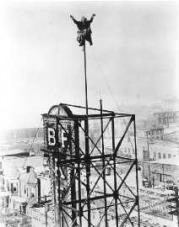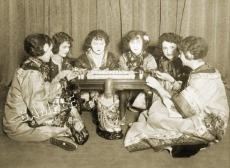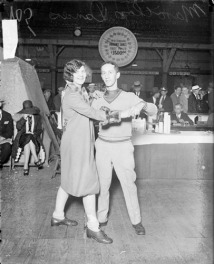From Flagpole Sitters to Mah-jongg; Popular Contests and Games

Stunt actor Alvin "Shipwreck" Kelly entered the scene in January of 1924 on a dare; dared by his friend to go sit on a flagpole. (In fact, there were many other "Shipwreck" Kellys. There was John "Shipwreck" Kelly, the pro football player, and a Paul "Shipwreck" Kelly.) Alvin "Shipwreck" Kelly allegedly claimed to have been on the Titanic but that's confirmed to be false. But, there may have been another Alvin Kelly on the crew, and Shipwreck may have just taken the credit. But that's just speculation.
Kelly was born Aloysius Kelly in Hell's Kitchen, a West Side NY neighborhood. There are conflicting dates given as his birth; most say May 13th, 1893, while a few say 1885. He was an orphan at birth, his mother having died during childbirth. Seven months after, his father fell to his death. Kelly ran away at 13 to work on the New York waterfront. He went around working as a boxer, steelworker, and eventually became a Hollywood movie stuntman. He got his nickname by being an ex-sailor who claimed to have been shipwrecked many times. As a professional boxer, "glass-jaw" Kelly was knocked out so many times that fans yelled, "Sailor Kelly has been shipwrecked again." The name stuck.
But then the history gets murkier. Supposedly, a theater owner was looking for some publicity and so hired Kelly to climb to the top of the house flagpole and stay there for thirteen hours. He stayed up there for 13 hours 13 minutes. The Los Angeles police had to send out people to control the crazed masses of curiosity-overcome spectators. By the time he came down, he had offers from movie theaters all over the country asking him to do the same thing for their theater. He'd just gotten a new job.
Many people copied what Kelly was doing and some even preformed under his name. The real Kelly was said to once have counted 17 other "Shipwreck" Kellys working at the same time. It was an extreme fad, with others setting record of seventeen and twenty-one days. Flagpole sitting was a form of entertainment, that practically anyone could enjoy. In 1929, Kelly set the world record record for flagpole sitting by staying up there for 23 days. On his descent he was treated like a hero, with kids ages eight and up sitting on poles and trees all over. Kelly eventually broke his own record in 1930 by sitting on a flagpole in Atlantic City, New Jersey, for 49 days-- seven weeks! (Some say that that record was broken soon after by Bill Penfield in Strawberry Point, Iowa, who sat on a flagpole for 51 days and 20 hours until a thunderstorm brought him down.) By the end of Kelly's career he had logged 20,613 hours of flagpole-sitting (210 in subfreezing weather, 1,400 in the rain). In 1939, Kelly was photographed preforming a headstand on a plank sticking out of the 54th story of a NY skyscraper, while eating doughnuts handed to him by an assistant. It was National Doughnut Dunking Week.
Kelly was born Aloysius Kelly in Hell's Kitchen, a West Side NY neighborhood. There are conflicting dates given as his birth; most say May 13th, 1893, while a few say 1885. He was an orphan at birth, his mother having died during childbirth. Seven months after, his father fell to his death. Kelly ran away at 13 to work on the New York waterfront. He went around working as a boxer, steelworker, and eventually became a Hollywood movie stuntman. He got his nickname by being an ex-sailor who claimed to have been shipwrecked many times. As a professional boxer, "glass-jaw" Kelly was knocked out so many times that fans yelled, "Sailor Kelly has been shipwrecked again." The name stuck.
But then the history gets murkier. Supposedly, a theater owner was looking for some publicity and so hired Kelly to climb to the top of the house flagpole and stay there for thirteen hours. He stayed up there for 13 hours 13 minutes. The Los Angeles police had to send out people to control the crazed masses of curiosity-overcome spectators. By the time he came down, he had offers from movie theaters all over the country asking him to do the same thing for their theater. He'd just gotten a new job.
Many people copied what Kelly was doing and some even preformed under his name. The real Kelly was said to once have counted 17 other "Shipwreck" Kellys working at the same time. It was an extreme fad, with others setting record of seventeen and twenty-one days. Flagpole sitting was a form of entertainment, that practically anyone could enjoy. In 1929, Kelly set the world record record for flagpole sitting by staying up there for 23 days. On his descent he was treated like a hero, with kids ages eight and up sitting on poles and trees all over. Kelly eventually broke his own record in 1930 by sitting on a flagpole in Atlantic City, New Jersey, for 49 days-- seven weeks! (Some say that that record was broken soon after by Bill Penfield in Strawberry Point, Iowa, who sat on a flagpole for 51 days and 20 hours until a thunderstorm brought him down.) By the end of Kelly's career he had logged 20,613 hours of flagpole-sitting (210 in subfreezing weather, 1,400 in the rain). In 1939, Kelly was photographed preforming a headstand on a plank sticking out of the 54th story of a NY skyscraper, while eating doughnuts handed to him by an assistant. It was National Doughnut Dunking Week.
But how did Kelly manage to stay up there all that time? He still had to eat and drink and live like any other person. He often drank coffee and smoked while up top. He would have food and drinks hoisted up to him in a basket with a rope and pulley. He learned to catnap by locking his thumbs in the holes in the flagpole staff. If he happened to sway while dozing, the pain in his thumbs would cause him to right himself, without even waking up. And if he had to go to the bathroom he would use a hose along the side of the pole or a bowl that was brought up by the pulley system. He'd use a blanket as a sort of modesty curtain.
There were also many other popular contests or games during the Roaring Twenties. A fad among college kids was goldfish swallowing, or seeing who could swallow the most goldfish. Another fad was seeing how many people could be gotten to fit in a telephone booth. There were also six-day bicycle races, where bikers would ride to wherever they were going, riding almost non-stop for six days, and mountain climbing. Other fads included Crossword puzzles and Ouija Boards (for contacting the dead).
A very popular game in the 20's was Mah-jongg (also spelled Mahjong, Mahjongg, Mah Jong, or Mah Jongg). Originally played in China, it was popularized around the world in the 1920's, particularly by the Japanese, Americans, and British.
It was brought over to America by Joseph P. Babcock, who began importing sets in bulk to the U.S. in 1922. To make it a commercial success he simplified the rules drastically, and while this worked, Americans weren't totally satisfied with this version and began to embellish it with "special hands" and new, added rules. The two most popular versions of the game in 1924 were the One-Double and Cleared-Hand games. Little was known about the classical game from China. However, people eventually lost interest in the game until 1935, when new "official" rules were published by the National Mah Jong League Inc.
But for the time being, in the 20's, Mah-jongg was an extremely popular game, especially among women. They'd come over to each others' houses in groups and sit down to a long game. They even liked to dress up in costumes from the country that Mah-jongg was from. However, because of the cultural confusion, many women wore Japanese kimonos instead of Chinese-style clothing.
A very popular game in the 20's was Mah-jongg (also spelled Mahjong, Mahjongg, Mah Jong, or Mah Jongg). Originally played in China, it was popularized around the world in the 1920's, particularly by the Japanese, Americans, and British.
It was brought over to America by Joseph P. Babcock, who began importing sets in bulk to the U.S. in 1922. To make it a commercial success he simplified the rules drastically, and while this worked, Americans weren't totally satisfied with this version and began to embellish it with "special hands" and new, added rules. The two most popular versions of the game in 1924 were the One-Double and Cleared-Hand games. Little was known about the classical game from China. However, people eventually lost interest in the game until 1935, when new "official" rules were published by the National Mah Jong League Inc.
But for the time being, in the 20's, Mah-jongg was an extremely popular game, especially among women. They'd come over to each others' houses in groups and sit down to a long game. They even liked to dress up in costumes from the country that Mah-jongg was from. However, because of the cultural confusion, many women wore Japanese kimonos instead of Chinese-style clothing.
Dance marathons were also a very popular contest in the Roaring Twenties. The craze started in 1923, when 32-year-old Alma Cummings danced for 27 hours straight, wearing out six different partners and breaking the previous British record. Others, mostly women, wanted some of that glory too.
Local dance studios were set up all over the country. However, after '23 dance marathons seemed to change. They became endless, grueling marathons that would go on for weeks, with both rules and audiences. They provided non-stop entertainment. Remember, this was before TV. The new rules regulated practically everything, from switching partners (no longer allowed) and rest periods (15 minutes per hour). There was even a 1920's reality show -- Survivor With a Twist. Couples would dance popular dances for as long as possible while judges watched to make sure that their knees didn't touch the ground.
The most famous and financially successful dance marathon was Milton Crandall's national "Dance Derby of the Century," in 1928. It provided not only the dancing, but also exhibition dancers, variety performers, "Shipwreck" Kelly, and special "unexpected" guests such as Texas Guinan, Prohibition's most infamous speakeasy owner. The Derby ran from June 10th to the 30th, until the health commissioner came in and closed it down. The $5,000 prize money was split among the remaining eight couples.
The longest recorded record for marathon dancing was a stunning three weeks!
The 1920's were a time of exhilaration and instant fads, fashion and fame. Most of the popular contests tested human endurance to its limit, stretching a person's stamina as far as it'd go. People loved life in the 20's, and knew how to live it big. After all, they weren't called the "Roaring Twenties" for nothing!
Local dance studios were set up all over the country. However, after '23 dance marathons seemed to change. They became endless, grueling marathons that would go on for weeks, with both rules and audiences. They provided non-stop entertainment. Remember, this was before TV. The new rules regulated practically everything, from switching partners (no longer allowed) and rest periods (15 minutes per hour). There was even a 1920's reality show -- Survivor With a Twist. Couples would dance popular dances for as long as possible while judges watched to make sure that their knees didn't touch the ground.
The most famous and financially successful dance marathon was Milton Crandall's national "Dance Derby of the Century," in 1928. It provided not only the dancing, but also exhibition dancers, variety performers, "Shipwreck" Kelly, and special "unexpected" guests such as Texas Guinan, Prohibition's most infamous speakeasy owner. The Derby ran from June 10th to the 30th, until the health commissioner came in and closed it down. The $5,000 prize money was split among the remaining eight couples.
The longest recorded record for marathon dancing was a stunning three weeks!
The 1920's were a time of exhilaration and instant fads, fashion and fame. Most of the popular contests tested human endurance to its limit, stretching a person's stamina as far as it'd go. People loved life in the 20's, and knew how to live it big. After all, they weren't called the "Roaring Twenties" for nothing!




